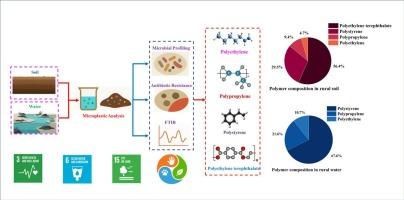Biofilm-associated microplastic contamination in rural soil and water: emerging hazards to ecosystems
IF 8
1区 环境科学与生态学
Q1 ENVIRONMENTAL SCIENCES
引用次数: 0
Abstract
Lack of regulation on disposal of plastic materials in rural areas has led to constant infiltration of microplastics (MPs) into soil and water cycle, threatening ecological stability. This paper examines micro plastics contamination within rural dumpsites and surrounding water bodies through an amalgamation of FTIR spectroscopy, microbial examination, as well as antibiotic resistance testing. Polyethylene (PE), polypropylene (PP), polystyrene (PS), and polyethylene terephthalate (PET) were the dominant polymers detected, with PET and PS comprising 56.43 % and 29.46 % of soil MPs, while PS alone contributed 51.36 % in water samples. FTIR spectra showed oxidized functional group, hence, accorded high degradation of the polymer when subjected to environmental exposure. In microbial examination, Gram-positive and Gram-negative bacillus were found to be colonizing the MP surfaces and the observation highlighted high resistance toward streptomycin in disk diffusion analysis. Conversely, imipenem and sulfisomidine had good bacterial inhibitory effect whereby the zones of inhibition were greater than 1200 μm. This indicated that they retained their activities. These discoveries indicate the twofold threat of pollution with chemicals and the rise of antimicrobial resistance caused by the collection of microplastic in the rural ecosystems with low regulatory capacities. The results imply that the enhanced strategy on waste management and environmental monitoring in the given setting is vital. The work is effectively linked to the Sustainable Development Goals: SDG 3 (good health and well-being), SDG 6 (clean water and sanitation), and SDG 15 (life on land); this effort will enhance the One Health approach and its comprehensive form.

农村土壤和水中与生物膜相关的微塑料污染:对生态系统的新危害
农村地区缺乏对塑料材料处理的监管,导致微塑料(MPs)不断渗入土壤和水循环,威胁生态稳定。本文通过FTIR光谱,微生物检查以及抗生素耐药性测试的合并检查农村垃圾场和周围水体中的微塑料污染。聚乙烯(PE)、聚丙烯(PP)、聚苯乙烯(PS)和聚对苯二甲酸乙二醇酯(PET)是土壤中检测到的主要聚合物,其中PET和PS分别占土壤MPs的56.43%和29.46%,而PS单独占水样中MPs的51.36%。FTIR光谱显示出氧化官能团,因此聚合物在环境暴露时具有高降解性。在微生物学检查中,发现革兰氏阳性和革兰氏阴性杆菌定植在MP表面,并在磁盘扩散分析中观察到对链霉素的高耐药性。亚胺培南和磺胺嘧啶抑菌效果较好,抑菌区均大于1200 μm。这表明他们保留了他们的活动。这些发现表明,在监管能力较低的农村生态系统中,化学品污染和微塑料收集造成的抗菌素耐药性上升存在双重威胁。结果表明,在特定环境中加强废物管理和环境监测战略是至关重要的。这项工作与可持续发展目标有效地联系在一起:可持续发展目标3(良好健康和福祉)、可持续发展目标6(清洁水和卫生设施)和可持续发展目标15(陆地上的生命);这一努力将加强“同一个健康”方针及其全面形式。
本文章由计算机程序翻译,如有差异,请以英文原文为准。
求助全文
约1分钟内获得全文
求助全文
来源期刊

Science of the Total Environment
环境科学-环境科学
CiteScore
17.60
自引率
10.20%
发文量
8726
审稿时长
2.4 months
期刊介绍:
The Science of the Total Environment is an international journal dedicated to scientific research on the environment and its interaction with humanity. It covers a wide range of disciplines and seeks to publish innovative, hypothesis-driven, and impactful research that explores the entire environment, including the atmosphere, lithosphere, hydrosphere, biosphere, and anthroposphere.
The journal's updated Aims & Scope emphasizes the importance of interdisciplinary environmental research with broad impact. Priority is given to studies that advance fundamental understanding and explore the interconnectedness of multiple environmental spheres. Field studies are preferred, while laboratory experiments must demonstrate significant methodological advancements or mechanistic insights with direct relevance to the environment.
 求助内容:
求助内容: 应助结果提醒方式:
应助结果提醒方式:


